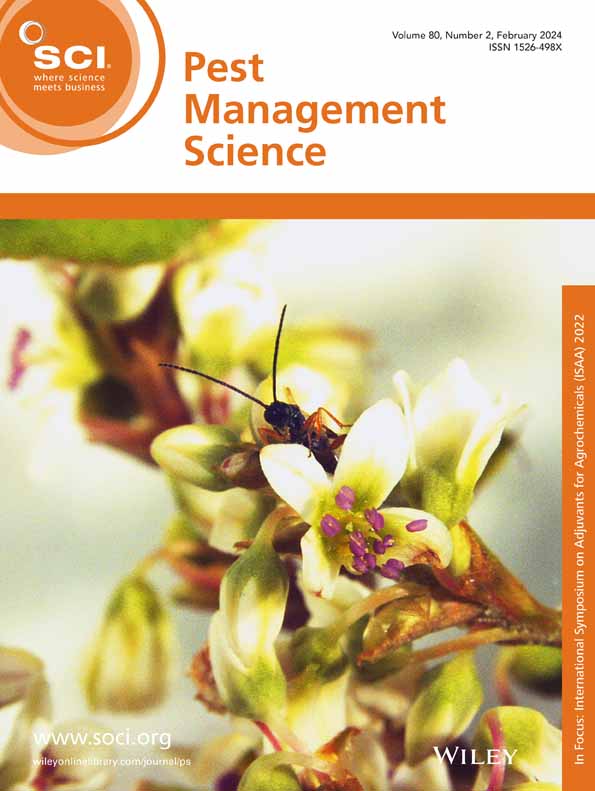马铃薯叶片衰老影响青桃蚜的嗅觉和取食偏好。
IF 3.8
1区 农林科学
Q1 AGRONOMY
引用次数: 0
摘要
叶面衰老是一个生理过程,涉及叶绿素和蛋白质的降解,氮化合物,特别是氨基酸,被动员到植物的其他部分。这一过程丰富了韧皮部,提高了蚜虫等韧皮部吸吮昆虫的营养质量。研究了马铃薯叶片自然衰老和诱导衰老对绿桃蚜(Myzus persicae Sulzer)取食和嗅觉行为的影响。研究了两个物候阶段:用透气性遮光布覆盖幼嫩植株的基叶诱导衰老,成熟植株的基叶自然衰老。叶绿素和蛋白质水平被量化以确认衰老,挥发性有机化合物(VOCs)被气相色谱-质谱(GC-MS)鉴定。结果自然或诱导衰老均可降低叶绿素和蛋白质水平。在幼嫩植株中,叶片衰老的诱导倾向于增加蚜虫的取食和嗅觉偏好。相比之下,在成熟植物中,蚜虫在嗅觉和摄食试验中始终更喜欢未衰老的顶叶而不是衰老的基叶。此外,成熟植物未衰老的顶端叶片释放的β-石竹烯含量明显高于衰老叶片,这可能反映了挥发物排放的总体增加。结论诱导衰老比自然衰老更能提高叶片的营养品质,有利于蚜虫的繁殖。对蚜虫寄主偏好的了解可以用于未来的控制策略,通过促进农业实践,最大限度地减少由高播种密度或营养不平衡等因素引起的衰老诱导。©2025化学工业协会。本文章由计算机程序翻译,如有差异,请以英文原文为准。
Potato leaf senescence affects the olfactory and feeding preferences of the green peach aphid, Myzus persicae.
BACKGROUND
Foliar senescence is a physiological process involving the degradation of chlorophyll and proteins, with nitrogen compounds, especially amino acids, mobilised to other parts of the plant. This process enriches the phloem, and improves its nutritional quality for phloem sucking insects like aphids. This study investigated how natural and induced leaf senescence affect the feeding and olfactory behaviour of the green peach aphid (Myzus persicae Sulzer) in potato (Solanum tuberusom L.). Two phenological stages were examined: young plants where senescence was induced in the basal leaves by covering them with a gas-permeable, light-blocking cloth, and mature plants with naturally senescent basal leaves. Chlorophyll and protein levels were quantified to confirm senescence, and volatile organic compounds (VOCs) were identified using gas chromatography-mass spectrometry (GC-MS).
RESULTS
Senescence, both natural or induced, reduced chlorophyll and protein levels. In young plants, the induction of leaf senescence tended to increase aphid feeding and olfactory preference. In contrast, in mature plants, aphids consistently preferred non-senescent apical leaves over senescent basal leaves sin both olfactory and feeding assays. Additionally, non-senescent apical leaves of mature plants released significantly higher levels of β-caryophyllene compared to senescent leaves, likely reflecting an overall increase in volatiles emission.
CONCLUSION
The results suggest that senescence induction, rather than natural senescence, enhances the nutritional quality of the leaves, allowing aphid propagation. Insights into aphid host preference can be used in future control strategies by promoting agricultural practices that minimise senescence induction caused by factors such as shading due to high sowing density, or nutrient imbalance. © 2025 Society of Chemical Industry.
求助全文
通过发布文献求助,成功后即可免费获取论文全文。
去求助
来源期刊

Pest Management Science
农林科学-昆虫学
CiteScore
7.90
自引率
9.80%
发文量
553
审稿时长
4.8 months
期刊介绍:
Pest Management Science is the international journal of research and development in crop protection and pest control. Since its launch in 1970, the journal has become the premier forum for papers on the discovery, application, and impact on the environment of products and strategies designed for pest management.
Published for SCI by John Wiley & Sons Ltd.
 求助内容:
求助内容: 应助结果提醒方式:
应助结果提醒方式:


